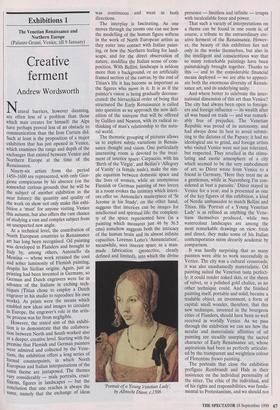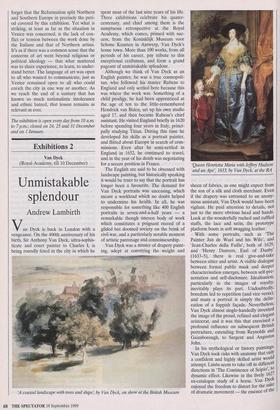Exhibitions 1
The Venetian Renaissance and Northern Europe (Palazzo Grassi, Venice, till 9 January)
Creative ferment
Andrew Wordsworth
Natural barriers, however daunting, are often less of a problem than those which man creates for himself: the Alps have perhaps proved less of an obstacle to communication than the Iron Curtain did. Such at least is the proposition of a major exhibition that has just opened in Venice, which examines the range and depth of the exchanges that existed between Venice and Northern Europe at the time of the Renaissance.
Ninety-six artists from the period 1450-1600 are represented, with only Gior- gione conspicuous by his absence (on the somewhat curious grounds that he will be the subject of another exhibition in the near future): the quantity and quality of the work on show not only make this exhi- bition a 'must' for anyone visiting Venice this autumn, but also offers the rare chance of studying a vast and complex subject from an unexpected new angle. At a technical level, the contribution of North European countries to Renaissance art has long been recognised. Oil painting was developed in Flanders and brought to Italy by, among others, Antonello da Messina — whose work retained the cool and sober luminosity of Flemish painting, despite his Sicilian origins. Again, just as printing had been invented in Germany, so German and Dutch engravers were far in advance of the Italians in etching tech- niques (Titian chose to employ a Dutch engraver in his studio to reproduce his own Works). As prints were the means which enabled new ideas and images to circulate in Europe, the engraver's role in the artis- tic process was far from negligible. However, the stated aim of this exhibi- tion is to demonstrate that the collabora- tion between North and South worked also at a deeper, creative level. Starting with the premise that Flemish and German painters were admired and collected by the Vene- tians, the exhibition offers a long series of formal counterpoints, in which North European and Italian interpretations of the same theme are juxtaposed. The themes vary considerably — male portraits, cruci- fixions, figures in landscapes — but the conclusion that one reaches is always the same, namely that the exchange of ideas was continuous and went in both directions.
The interplay is fascinating. As one moves through the rooms one can see how the modelling of the human figure softens in the work of North European artists as they enter into contact with Italian paint- ing, or how the Northern feeling for land- scape, and for the direct observation of nature, modifies the Italian sense of com- position. With Bellini, landscape is seldom more than a background, or an artificially framed section of the canvas; by the end of Titian's life it has become as important as the figures who move in it. It is as if the painter's vision is being gradually deconse- crated: the hierarchical order of being that structured the Early Renaissance is called into question as we approach the new defi- nition of the universe that will be offered by Galileo and Newton, with its radical re- thinking of man's relationship to the natu- ral world.
The thematic grouping of pictures allows us to explore subtle variations in Renais- sance thought and vision. One particularly interesting room is devoted to the treat- ment of interior space: Carpaccio, with his `Birth of the Virgin', and Bellini's 'Allegory of Vanity' (a female nude), make the sim- ple equation between domestic space and the lives of women, while an anonymous Flemish or German painting of two lovers in a room evokes the intimacy which interi- ors offer us. Antonello's masterpiece of 'St Jerome in his Study', on the other hand, suggests that interiors can be images for intellectual and spiritual life: the complexi- ty of the space represented here (in a painting which measures just 46 by 36.5 cms) somehow suggests both the intricacy of the human brain and its almost infinite capacities. Lorenzo Lotto's 'Annunciation', meanwhile, sees interior space as a man- made fabrication (protective, clearly defined and limited), into which the divine Portrait of a Young Venetian Lady, by Albrecht Darer, c.1506 presence — limitless and infinite — irrupts with incalculable force and power.
That such a variety of interpretations on a theme can be found in one room is, of course, a tribute to the extraordinary cre- ative ferment of the Renaissance. Howev- er, the beauty of this exhibition lies not only in the works themselves, but also in the intelligent and conscientious way that so many remarkable paintings have been painstakingly brought together. Thanks to this — and to the considerable financial means deployed — we are able to appreci- ate both the enormous diversity of Renais- sance art, and its underlying unity.
And where better to celebrate the inter- national dimension of this art than Venice? The city had always been open to foreign- ers and foreign influence — its wealth after all was based on trade — and was remark- ably free of prejudice. The Venetian Republic was proud of its autonomy, and had always done its best to avoid submit- ting to the dictates of the Papacy; it had no ideological axe to grind, and foreign artists who visited Venice were not just tolerated, but respected. They revelled in the stimu- lating and exotic atmosphere of a city which seemed to be the very embodiment of art: so Dtirer wrote from Venice to a friend in Germany, 'Here they treat me as a gentleman, while in Nuremberg I'm con- sidered at best a parasite.' Ditrer stayed in Venice for a year, and is presented as one of the key figures of this exhibition, a kind of Nordic ambassador to match Bellini and Titian. His 'Portrait of a Young Venetian Lady' is as refined as anything the Vene- tians themselves produced, while two watercolour landscapes are among the most remarkable drawings on view: fresh and direct, they make some of his Italian contemporaries seem drearily academic by comparison.
It was hardly surprising that so many painters were able to work successfully in Venice. The city was a cultural crossroads; it was also unashamedly materialistic. Oil painting suited the Venetian taste perfect- ly: it could render naked skin, or the sheen of velvet, or a polished gold chalice, as no other technique could. And the finished painting itself, portable and solid, became a tradable object, an investment, a form of capital: small wonder, therefore, that this new technique, invented in the bourgeois cities of Flanders, should have been so well received in worldly Venice. As we pass through the exhibition we can see how the secular and materialistic affinities of oil painting are steadily usurping the sacred character of Early Renaissance art, whose aspirations had been so perfectly articulat- ed by the transparent and weightless colour of Florentine fresco painting.
The portraits that close the exhibition prefigure Rembrandt and Hals in their insistence on the individual personality of the sitter. The ethic of the individual, and of his rights and responsibilities, was funda- mental to Protestantism, and we should not forget that the Reformation split Northern and Southern Europe in precisely the peri- od covered by this exhibition. Yet what is striking, at least as far as the situation in Venice was concerned, is the lack of con- flict or tension between the work done by the Italians and that of Northern artists. It's as if there was a common sense that the concerns of art went beyond religious or political ideology — that what mattered was to share experience, to learn, to under- stand better. The language of art was open to all who wanted to communicate, just as Venice remained open to all who could enrich the city in one way or another. As we reach the end of a century that has known so much nationalistic intolerance and ethnic hatred, that lesson remains as relevant as ever.



























































































 Previous page
Previous page